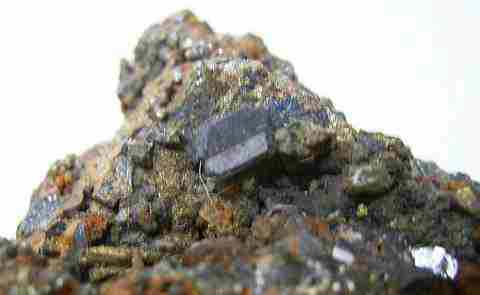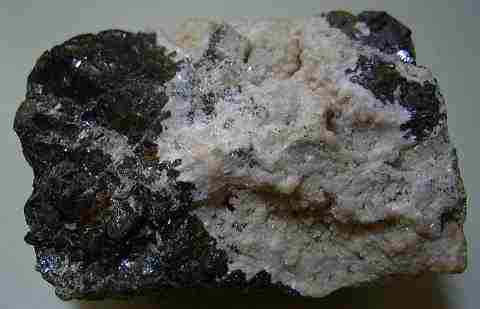Sphalerite
Daikoku Deposit, Chichibu Mine
Otaki, Chichibu city, Saitama pref., Japan
Source for Zinc, Cadmium, and Sulfuric acid.

Field of view: 20 mm. A spinel twin of sphalerite. The black crystal at the center is a spinel twin of sphalerite. The black part exhibiting perfect cleavage at the bottom is also sphalerite. The fine yellow grains with a metallic luster are pyrite. The brown parts are limonite crusts.
Recovered from an open space of sulfide minerals in a moderately low-temperature hydrothermal deposit combined with skarn formed by contact metamorphism of I-type (magnetite-series) quartz diorite. Formed in the late Miocene (6 Ma).
Sphalerite from this location was described in 1930.

Field of view: 50 mm. Sphalerite associated with rhodochrosite. The black parts exhibiting perfect cleavage with a submetallic luster are sphalerite. The pale pink parts exhibiting obvious cleavage are rhodochrosite, and there are some euhedral rhombohedrons. The fine silver-white grains in rhodochrosite are arsenopyrite.
Other localities
- Kamioka Mine (Pneumatolytic Skarn, Granular)
- Chichibu Mine (Hydrothermal Skarn, Twin)
- Nakatatsu Mine (Hydrothermal Skarn)
- Kawai Mine (Hydrothermal Skarn, Massive)
- Hagidaira Mine (Mn Skarn, Granular)
- Arakawa Mine (Hydrothermal, Transparent)
- Kawazu Mine (Hydrothermal, Granular)
- Mikawa Mine (Hydrothermal, Granular)
- Sayama Mine (Hydrothermal, Veinlet)
- Manju Mine (Hydrothermal, Massive)
- Hikida Mine (Hydrothermal, Granular)
- Agenosawa Mine (Hydrothermal, Massive)